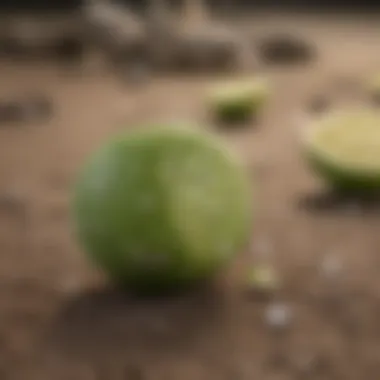Lime for Snakes: Enhancing Serpent Habitats Wisely


Intro
The care of snakes as pets or in wildlife settings often requires attention to various environmental factors. Among these, an often overlooked material is lime. The use of lime in snake habitats can bring several advantages, but understanding its role and implications is essential for optimal serpent care.
Lime, which primarily consists of calcium carbonate, plays a significant part in habitat management. Its applications can affect soil pH, improve drainage, and contribute to a healthier ecosystem for snakes. However, the chemistry behind lime and its interaction with the surrounding environment means that careful consideration is needed.
In this article, we will explore the fundamentals of lime in relation to snakes. This involves detailing its properties, potential benefits, and the precautions necessary when introducing it into snake habitats. Our goal is to provide a thorough guide that supports informed decision-making for animal enthusiasts, educators, and wildlife caretakers.
Prolusion to Lime in Herpetology
Lime plays a significant role in the care and management of snake habitats. Understanding its application is critical for maintaining a balanced environment that promotes both snake health and ecosystem integrity. Lime not only aids in soil amendment but also affects the overall quality of habitats where snakes are found. Recognizing how lime interacts with the surrounding ecosystem can lead to more informed habitat management decisions.
Defining Lime and Its Types
Lime primarily refers to the products derived from limestone, which consists mostly of calcium carbonate. This compound can be processed to produce different types of lime, each with unique properties and applications. The main types of lime used in environmental management include:
- Calcium Lime: Also known simply as agricultural lime, it is primarily used to increase soil pH. It helps neutralize acidic soils, making them more conducive for plant growth.
- Dolomitic Lime: This type contains magnesium carbonate alongside calcium carbonate. Dolomitic lime is particularly beneficial when soil magnesium levels are low.
Both types of lime play an essential role in improving soil structure and fertility, thus enhancing the habitat for snakes and other wildlife.
Historical Use of Lime in Agriculture
Lime has been utilized in agricultural practices for centuries. Its historical significance is rooted in its ability to amend soil properties. Farmers observed that applying lime transformed acidic soils into more productive landscapes. This knowledge paved the way for its broader application in habitat management for various species, including snakes.
Lime's historical applications reflect a deep understanding of soil chemistry, guiding agricultural practices to improve yield and sustainability.
"Lime, in many ways, is an ancient solution that continues to play a critical role in contemporary ecosystem management."
Through centuries of agricultural practices, the connection between lime and robust soil health has proven vital. This continuing legacy reinforces the importance of lime for modern serpent care and habitat management.
Chemical Composition of Lime
The chemical composition of lime plays a crucial role in understanding its applications in snake care and habitat management. Lime primarily consists of two important types, each possessing unique properties and benefits that can influence the environment where snakes thrive. Knowing these differences allows for better decision making for snake enthusiasts and caretakers.
Types of Lime: Calcium and Dolomitic
Lime used in habitat management generally falls into two major categories: calcium lime and dolomitic lime.
- Calcium Lime: This type primarily contains calcium oxide and is ideal for rapidly increasing soil pH levels. It enhances soil fertility, promoting the growth of healthy flora that can provide essential cover for snakes. By boosting soil quality, calcium lime also supports beneficial microorganisms that contribute to a balanced ecosystem.
- Dolomitic Lime: Comprised of both calcium carbonate and magnesium carbonate, dolomitic lime not only raises pH levels but also adds magnesium to the soil. This can be particularly beneficial in areas where magnesium is deficient. Overall, the presence of magnesium can improve the health of plants, leading to better shelter opportunities for snakes.
Both types serve as effective soil amendments, but the choice between them largely depends on specific soil deficiencies and the needs of the local ecosystem.
pH Levels and Soil Chemistry


Understanding pH levels in soil is essential when incorporating lime into snake habitats. The pH scale ranges from 0 to 14, where 7 is neutral.
- Acidic Soils: Many soils, especially in certain regions, can be overly acidic. Such conditions can limit the growth of necessary vegetation, impacting the overall habitat. Lime application raises the soil pH, which in turn can promote the growth of a wider variety of plants. This results in a richer habitat for snakes, offering them both shelter and food sources.
- General Benefits:
- Improved nutrient availability: Many nutrients become more accessible to plants at a pH closer to neutral.
- Enhanced microbial activity: Beneficial soil bacteria thrive in more neutral pH conditions, promoting organic matter breakdown.
- Better drainage: Lime amendments often facilitate improved drainage, reducing waterlogged conditions that can be detrimental to both plants and snakes.
Considering these aspects of lime enables better understanding and management of snake habitats. The environmental balance maintained through precise pH adjustments ultimately fosters a healthier ecosystem for these reptiles.
Lime's Role in Snake Habitat Management
Lime plays a pivotal role in managing habitats where snakes thrive. Understanding how lime can enhance the environment for these creatures is crucial for anyone interested in serpent care. Proper habitat management ensures that snakes have access to a clean, healthy ecosystem that supports their growth and behavior. This section will delve into two main aspects of lime's impact: enhancing soil quality and promoting plant life for shelter.
Enhancing Soil Quality
Soil quality is a fundamental component of any habitat. Lime, particularly calcium and dolomitic lime, can ameliorate soil acidity, which is essential for many plants that snakes depend on for shelter and food. By raising the pH of acidic soils, lime not only improves nutrient availability but also enhances microbial activity. This leads to a more balanced ecosystem.
When applying lime, it is important to conduct soil tests. Tests can reveal the current pH and nutrient levels, informing how much lime is needed for optimal soil condition. Proper application of lime typically results in improved soil structure, which increases water holding capacity. Healthy soil leads to robust plant growth. Such plants provide essential cover and foraging areas for snakes. The benefits of lime therefore extend beyond just soil quality; they directly influence snake health and behavior.
Promoting Plant Life for Shelter
Dense vegetation is crucial for snakes, providing not only shelter but also a habitat for their prey. Lime encourages the growth of various plant species that can thrive in improved soil. As plants grow, they create a more complex habitat that benefits a numerous wildlife species.
For instance, adding lime can increase the presence of grasses and shrubs. Certain species attract insects, which in turn draw snakes looking for a food source. Additionally, bushy vegetation provides hiding spots, protecting snakes from predators.
Using lime to convert a barren area into a flourishing habitat reveals remarkable results over time. However, it is crucial to monitor the ecosystem. Over-application of lime can lead to detrimental effects, including changes in plant species dominance, potentially harming the delicate balance of the habitat.
In summary, lime enhances soil quality and promotes plant life, both of which are important for creating and maintaining a suitable environment for snakes.
By recognizing these roles, those engaged in snake care can make more informed decisions about habitat management.
Benefits of Lime in Snake Care
The integration of lime in snake habitat management is far from trivial. Its application offers several notable advantages for both the environment and the health of snakes. Understanding these benefits can assist enthusiasts and caretakers in fostering optimal conditions for their reptilian charges. Two significant aspects necessitate careful examination: controlling parasites in habitats and improving drainage as well as moisture retention.
Controlling Parasites in Habitats
Parasites can pose serious threats to the health of snakes. They can lead to a range of health issues, from skin irritations to more complex systemic conditions. Lime possesses properties that can deter or reduce parasite populations in inhabited areas. When lime is applied to the soil, it raises the pH levels, creating an environment that is less hospitable to many parasites. This adjustment in soil chemistry can disrupt the life cycles of organisms such as nematodes or certain pathogenic fungi.
Furthermore, lime's benefits extend beyond immediate control. Regular application can contribute to long-term pest management strategies in a habitat. Snakes that occupy these areas benefit indirectly from a reduction in the organism that could afflict them.
Regular application of lime can lead to long-term decreases in parasite populations, significantly improving habitat health for snakes.


Improving Drainage and Moisture Retention
Drainage is critical for maintaining healthy snake habitats. Poor drainage can lead to waterlogged areas, creating unfavorable conditions for both snakes and their prey. Lime can enhance soil structure, promoting better drainage. When applied, it helps break up compacted soils, allowing for more effective movement of water through the ground. This is particularly essential in areas known for heavy rainfall.
In addition to aiding drainage, lime also supports moisture retention in a balanced way. While it allows excess water to escape, it simultaneously assists in maintaining adequate soil moisture levels necessary for plant life. Snakes rely on the plants and vegetation for shelter and hunting grounds. Healthy plant life contributes to stable microenvironments and provides necessary cover for these creatures.
In summary, the benefits of lime in snake care are multifaceted. From controlling harmful parasites to ensuring effective drainage and moisture retention, lime plays a pivotal role in creating a balanced ecosystem that supports snake welfare. Understanding these advantages can empower snake owners and wildlife enthusiasts to make informed decisions about habitat management.
Safety Considerations When Using Lime
When discussing lime's application in serpent care and habitat management, it is crucial to understand the safety aspects involved. Lime, while beneficial for soil health and snake habitats, can also pose risks if mishandled or applied improperly. This section will address the potential toxicity of lime to snakes and strategies for safe application.
Potential Toxicity to Snakes
Lime is known for its alkaline properties. When applied excessively or in concentrated forms, it can be harmful to various reptiles, including snakes. The toxicity generally arises from two factors:
- pH Imbalance: Snakes are sensitive to changes in the pH levels of their environment. High pH levels can affect their ability to absorb nutrients and may lead to health issues over time.
- Irritation and Ingestion Risk: Lime can be irritating to a snake's skin and respiratory system. If ingested, it can cause serious harm to their digestive tract. Thus, ensuring that lime applications do not come into direct contact with snakes is paramount.
"Awareness of the environmental impact of lime is necessary for maintaining the health of reptiles in their habitats."
Application Methods for Minimizing Risks
To ensure that the benefits of lime do not come at the cost of snake safety, specific application methods should be highlighted:
- Proper Dilution: Always dilute lime products according to manufacturer instructions. Diluted solutions can help manage pH levels without overwhelming the soil.
- Targeted Application: Apply lime only in areas that require it, avoiding regions frequented by snakes. This reduces the chance of direct contact.
- Post-Application Monitoring: After applying lime, observe the area for potential snake activity. If snakes are noticed in treated zones, careful steps should be taken to ensure their safety.
- Timing of Application: Applying lime during low snake activity periods may lessen the chance of exposing them to irritants. Late evening or early morning may be preferable.
- Environmental Assessments: Before applying lime, conduct a soil test to understand how much is needed. Over-application not only harms snakes but can also disrupt the ecological balance.
Research and Case Studies
Research and case studies serve as vital components in understanding the nuances of lime use in snake care. They provide empirical evidence and practical applications that inform best practices for habitat management. By examining real-world scenarios, researchers can delineate the effects of lime on soil quality, snake behavior, and overall ecosystem health. This section highlights pivotal studies and field trials that exemplify how lime interacts within different environments inhabited by snakes, offering insights into both benefits and potential drawbacks.
Studies on Lime Effects in Snake-Infested Areas
Studies conducted in regions where snake populations thrive have shed light on the role of lime in enhancing habitat conditions. Specific research has focused on areas infested by various snake species, investigating how lime application influences both the flora and fauna crucial to these environments.
For instance, a study published in a herpetological journal analyzed the impact of lime on soil pH and microbial activity in snake habitats. The findings revealed that lime not only decreased soil acidity but also fostered beneficial microbial communities. These changes in soil composition can lead to a more robust plant life, indirectly benefiting snakes by providing adequate cover and potential food sources.
Additionally, long-term monitoring of these habitats showed a decrease in certain parasitic populations that affect snakes. This underscores lime’s potential to play a dual role—to enhance habitat quality while also providing a healthier environment for snake populations.
Field Trials in Various Ecosystems
Field trials examining lime application across diverse ecosystems have further confirmed the substance's effectiveness in habitat management for snakes. Research teams have implemented lime in different geological and climatic regions to assess its impact on both soil chemistry and serpents' well-being.


One notable field trial took place in a temperate forest ecosystem where limestone deposits are abundant. Researchers measured the changes in soil characteristics over time, specifically focusing on lime's effect on nutrient bioavailability and moisture retention. They found that a calibrated amount of lime improved soil structure and capacity to retain moisture, which is beneficial not just for plant life but also for snakes that rely on specific microhabitats for thermoregulation.
"Understanding lime application is crucial for wildlife conservation efforts, especially in areas that support diverse snake populations."
Moreover, trials in arid environments have evaluated how lime can assist in combating desertification. The application of lime has reportedly improved vegetation cover, providing essential hiding spots for snakes while promoting a broader ecological balance. These research efforts illustrate the importance of conducting targeted field trials, as they contribute to a comprehensive understanding of how lime functions across different ecosystems.
Thus, the combination of studies and field trials facilitates a more profound comprehension of lime's multifaceted role in snake habitat management, offering valuable lessons for future research and practice.
Alternatives to Lime
The use of lime in snake habitat management presents several advantages, yet alternatives should also be considered. This section addresses various organic and inorganic substitutes that can maintain soil health and provide a suitable environment for snakes. Understanding these alternatives is crucial, as they may be more suitable depending on specific ecological conditions and management goals. By exploring these options, one can achieve a balanced approach that ensures the health of the ecosystem and the snakes that inhabit it.
Organic Alternatives for Soil Management
Organic alternatives offer a compelling choice for those looking to manage soil quality without the risks associated with lime. Materials such as compost, manure, and organic mulches can enhance soil fertility. Each of these provides essential nutrients while also improving moisture retention and drainage. Here are some significant organic alternatives:
- Compost: This is decomposed organic material that enriches soil. Compost adds beneficial microorganisms, which improve soil structure and nutrient availability.
- Manure: Animal waste can serve as an effective fertilizer. When well-aged, it is rich in nutrients that help stimulate plant growth, important for snake habitats.
- Organic Mulch: Applying organic mulch materials such as straw or wood chips can help with moisture retention while providing ground cover that may serve as a habitat for small invertebrates, food sources for snakes.
"Incorporating organic materials not only improves soil health but also fosters a richer, more diverse ecosystem essential for snake habitats."
These organic materials are generally safer for snakes and pose fewer health risks compared to lime. They support beneficial microbial life, which is vital for a healthy habitat. However, they may require more frequent applications to maintain optimal conditions.
Comparative Analysis with Other Soil Amendments
When evaluating alternatives, it is helpful to analyze how they measure against lime and each other. Soil amendments like gypsum, rock phosphate, and sulfur can serve specific needs.
- Gypsum: This option is beneficial in improving soil structure. It can help prevent compaction and lead to better drainage, which is crucial in managing wet habitats for snakes.
- Rock Phosphate: If the goal is to improve phosphorus levels, rock phosphate stands out. It is slower releasing compared to synthetic fertilizers, providing long-term benefits without the risk of nutrient runoff.
- Sulfur: Lowering soil pH without the rapid effects of lime can be achieved using sulfur. This is crucial when acidic conditions are desired for particular plant communities beneficial to snakes.
Culmination
The conclusion serves as a vital summary of the relevance and implications of using lime in snake care and habitat management. Throughout this article, we explored various aspects relating to lime’s chemical makeup, its benefits, potential risks, and alternative soil management techniques. It is essential for snake care enthusiasts, wildlife advocates, and researchers to understand the dual nature of lime as both a beneficial amendment and a substance that requires caution in its use.
Summarizing Key Points
The following key points encapsulate the findings covered in this article:
- Chemical Composition: Lime consists primarily of calcium carbonate or magnesium carbonate which can enhance soil quality and pH balance.
- Habitat Management: When applied correctly, lime can improve soil drainage and encourage healthy plant life; both of which support snake habitats.
- Benefits: Lime aids in controlling parasites, improving overall habitat health. However, it can be toxic if misused.
- Safety Considerations: Appropriate application methods are crucial to minimize risk to snake populations.
- Alternatives: Organic alternatives and other amendments can sometimes provide similar benefits without the associated risks of lime.
Understanding lime's role in snake habitats is crucial for responsible care and environment management.
Future Directions for Research
Future research avenues should focus on the following areas:
- Long-term Effects: Studying the long-term ecological impact of lime on snake habitats in various ecosystems can provide deeper insights into sustainable practices.
- Comparative Studies: It's vital to perform comparative analyses between lime and organic amendments to evaluate their effectiveness in different soil types and environments.
- Toxicity Research: Further investigation into the specific conditions that lead to lime toxicity in snakes will enhance safety protocols for habitat management.
- Behavioral Studies: Exploring how lime applications affect snake behavior and health can inform better care practices and habitat management strategies.
This knowledge can empower animal lovers, wildlife enthusiasts, and educators to make informed choices in habitat management while preserving the delicate balance of serpent welfare and environmental health.







